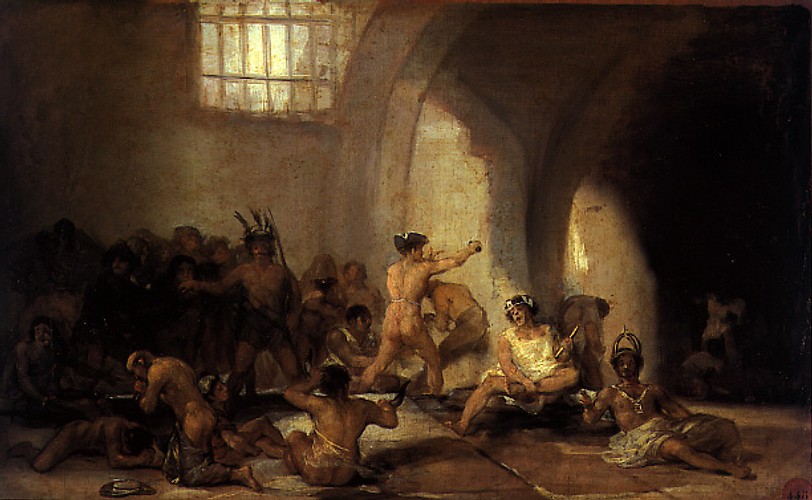Yard with Lunatics (Spanish: Corral de locos), also known as Yard with Madmen, is a small oil-on-tinplate painting by the Spanish artist Francisco Goya, produced between 1793 and 1794. Goya said it was informed by scenes of institutions he had witnessed as a youth in Zaragoza.[1] Yard with Lunatics was painted at a time when Goya’s deafness and fear of mental illness were developing, and he was increasingly complaining about his health. Don Sebastian Martinez, who cared for Goya in his house in Cadiz, wrote in a letter that “the noises in his [Goya’s] head and deafness aren’t improving, yet his vision is much better and he is back in control of his balance.”[2]
Goya had previously been preoccupied with commissioned portraits of royalty and noblemen, but this work is one of a dozen small-scale, dark images he produced independently. Uncommissioned, it was one of the first of Goya’s mid-1790s cabinet paintings, in which his earlier search for ideal beauty gave way to an examination of the relationship between naturalism and fantasy that would preoccupy him for the rest of his career.[3] Goya was at the time undergoing a nervous breakdown and entering a prolonged period of physical illness,[a]The cause of Goya’s maladies is uncertain. Theories range from polio to syphilis or lead poisoning, yet he lived until the age of 82. and admitted that the series was created to reflect his own self-doubt, anxiety and fear that he himself was going mad.[4] He wrote that the works served “to occupy my imagination, tormented as it is by contemplation of my sufferings.” The series, he said, consisted of pictures which “normally find no place in commissioned works.”[5]
To the art historian Arthur Danto, Yard with Lunatics marks the point in Goya’s career when he moves from “a world in which there are no shadows to one in which there is no light”.[5] The work is often compared to the more mature but equally bleak Madhouse of 1812–1819. It has been described as a “somber vision of human bodies without human reason”,[6] a “deeply disturbing visions of sadism and suffering, that, to a 20th-century viewer’s mind, conjure up memories of concentration camp photographs”.[7]
Set in a lunatic asylum, Yard with Lunatics was painted at a time when such institutions were, according to art critic Robert Hughes, no more than “holes in the social surface, small dumps into which the psychotic could be thrown without the smallest attempt to discover, classify, or treat the nature of their illness.”[8] Goya’s yard is stark, showing shackled inmates enclosed by high walls and a heavy stone arch. Inmates fight and grin idiotically or huddle in despair, all bathed in an oppressive grey and green light, guarded by one man.
In a letter written to his friend Bernardo de Yriarte in 1794, Goya wrote that the painting shows “a yard with lunatics, and two of them fighting completely naked while their warder beats them, and others in sacks”.[9] Goya’s words are usually seen as an indictment of the widespread punitive treatment of the insane, who were confined with criminals, put in iron manacles, and routinely subjected to physical punishment,[8] in ground sealed by masonry blocks and iron gate. Here the patients are variously staring, sitting, posturing, wrestling, grimacing or disciplining themselves. The top of the canvas vanishes with sunlight, emphasising the nightmarish scene below.
Yard with Lunatics is currently in the collection of the Meadows Museum in Dallas.[10]
Notes
| a | The cause of Goya’s maladies is uncertain. Theories range from polio to syphilis or lead poisoning, yet he lived until the age of 82. |
|---|
References
Bibliography
This article may contain text from Wikipedia, released under the Creative Commons Attribution-ShareAlike 4.0 International License.


